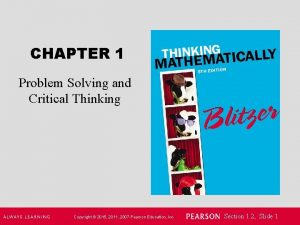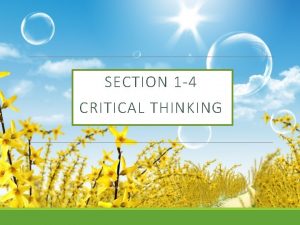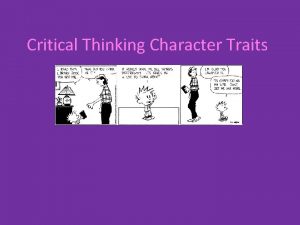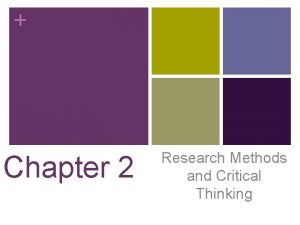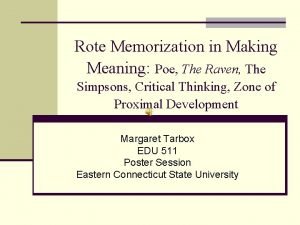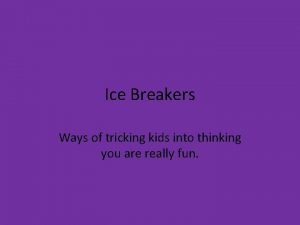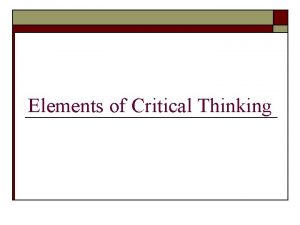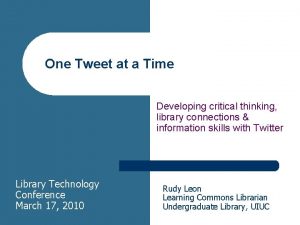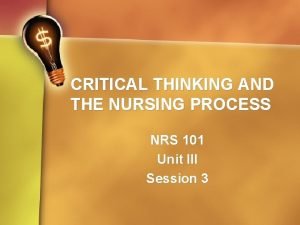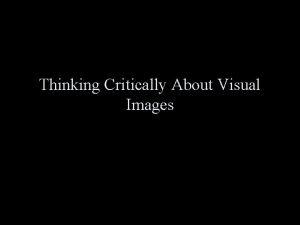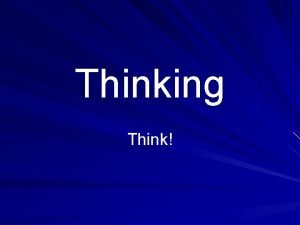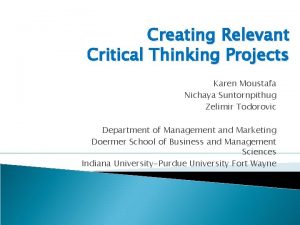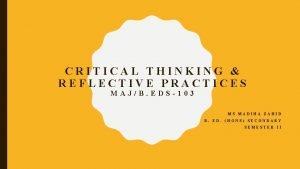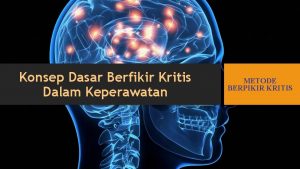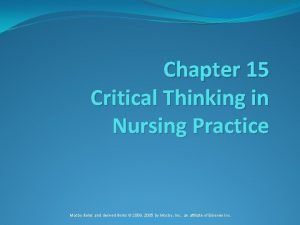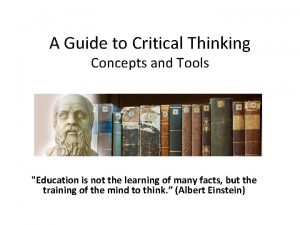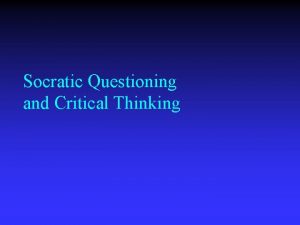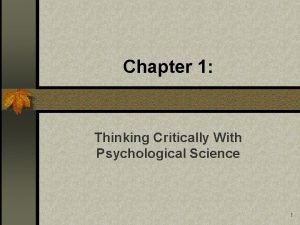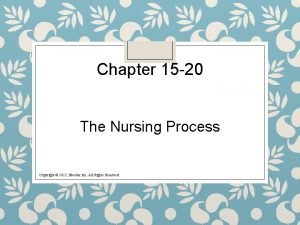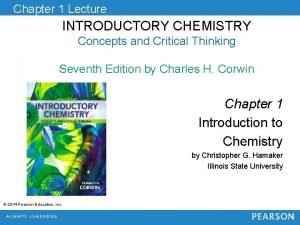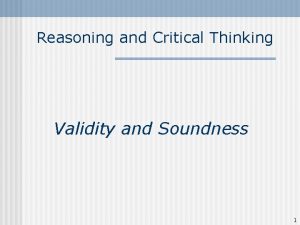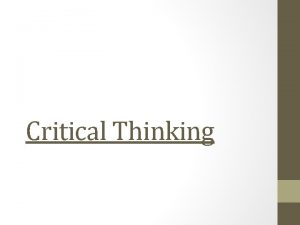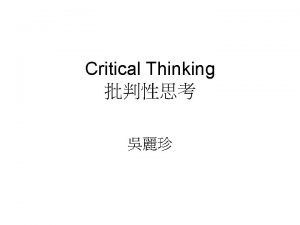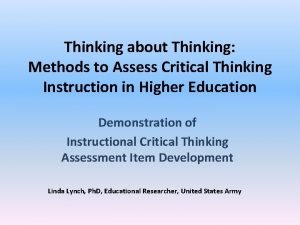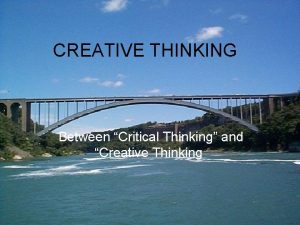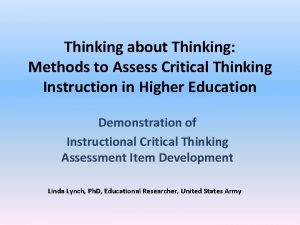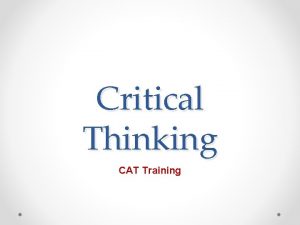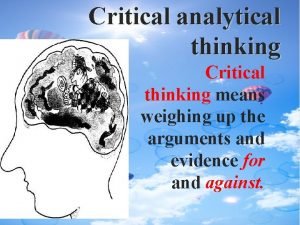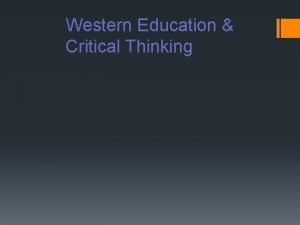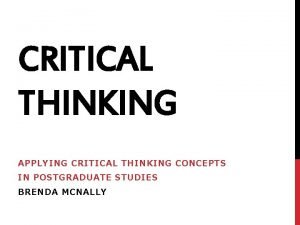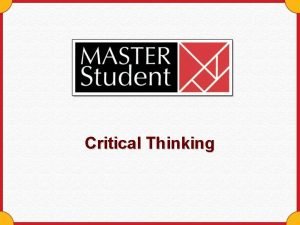Critical Thinking Week 4 Critical Thinking 2014 Fifteenyearold




































- Slides: 36

Critical Thinking Week 4 Critical Thinking 2014

Fifteen-year-old Avery Hairston created Relight. NY to help people who struggle to pay their energy bills by giving them compact flourescent light bulbs, which reduce long-term energy costs and are better for the environment than regular bulbs. Seventeen-year-old Kelydra Welcker invented an easy way to remove the chemical C 8 from her West Virginia town’s water supply. She believes everyone should be given clean and safe water to drink. Critical Thinking 2014

Because she has had an enormous effect on the problem of deforestation in Africa. She has been working with the United Nations to encourage people around the world to plant trees. Critical Thinking 2014

Critical Thinking 2014

Bloom’s Taxonomy

What is it? ? ? Bloom’s Taxonomy is a chart of ideas Named after the creator, Benjamin Bloom A Taxonomy is an arrangement of ideas or a way to group things together

Bloom’s Taxonomy You may see the levels organized differently in other charts

Who is Dr. Benjamin Bloom? ? He was a teacher, thinker, & inventor He worked at a college He created a list about how we think about thinking… you may want to read that again! 1913 -1999

The levels of thinking There are six levels of learning according to Dr. Bloom The levels build on one another. The six levels all have to do with thinking. Level one is the lowest level of thinking Level six is the highest level of thinking Knowledge Comprehension Application Analysis Synthesis Evaluation

New names? ? Some people have renamed these levels to make them easier to remember Knowledge- Remembering Comprehension- Understanding Application- Applying Some people even switch the last two levels around Analysis- Analyzing Synthesis- Creating Evaluation- Evaluation

Knowledge or Remembering observation and recall of information knowledge of dates, events, places knowledge of major ideas mastery of subject matter Key words: list, define, tell, describe, identify, show, label, collect, examine, tabulate, quote, name, who, when, where, etc.

Knowledge/Remembering- Do it… Write a list of vegetables.

Comprehension or Understanding understanding information grasp meaning translate knowledge into new context interpret facts, compare, contrast order, group, infer causes predict consequences Key words: summarize, describe, interpret, contrast, predict, associate, distinguish, estimate, differentiate, discuss, extend

Comprehension/ Understanding- Do it… Retell the story of the “Three Little Pigs” in your own words.

Application or Applying use information use methods, concepts, theories in new situations solve problems using required skills or knowledge Key words: apply, demonstrate, calculate, complete, illustrate, show, solve, examine, modify, relate, change, classify, experiment, discover

Application/Applying- Do it… Make a model of a swing set with paper and explain how it works.

Analysis or Analyzing seeing patterns organization of parts recognition of hidden meanings identification of components Key words: analyze, separate, order, explain, connect, classify, arrange, divide, compare, select, explain, infer

Analysis/ Analyzing- Do it… Make a family tree showing relationships.

Synthesis or Creating use old ideas to create new ones generalize from given facts relate knowledge from several areas predict, draw conclusions Key words: combine, integrate, modify, rearrange, substitute, plan, create, design, invent, what if? , compose, formulate, prepare, generalize, rewrite

Synthesis/Creating- Do it… Design a magazine cover that would appeal to students in your class.

Evaluation or Evaluating compare and discriminate between ideas assess value of theories, presentations make choices based on reasoned argument verify value of evidence recognize subjectivity Key words assess, decide, rank, grade, test, measure, recommend, convince, select, judge, explain, discriminate, support, conclude, compare, summarize

Evaluation/Evaluating- Do it… Make a booklet about 5 rules you see as important. Convince others.

Bloom’s Taxonomy and Research When doing research you should always start with the lower levels of thinking You must have basic knowledge before you can advance to deeper ideas One great way to improve your knowledge is to READ, READ about your research topic When doing research, always be sure to stretch your thinking to the higher levels of thinking After you’ve explored your basic knowledge base, challenge your self to new ideas Always keep a Bloom’s Taxonomy “cheat” sheet with you to help you hit the higher levels of thinking

Bloom’s Taxonomy- Do it… Print out the next slide. This is a kid’s friendly copy of Bloom’s Taxonomy and put it in your research folder for quick reference.

Source: http: //www. kurwongbss. eq. edu. au/thinking/Bloom/BLOOM%20(one%20 page%20 poster). doc Recalling information Recognising, listing, describing, retrieving, naming, finding Remembering Explaining ideas or concepts Interpreting, summarising, paraphrasing, classifying, explaining Understanding Using information in another familiar situation Implementing, carrying out, using, executing Applying Breaking information into parts to explore understandings and relationships Comparing, organising, deconstructing, interrogating, finding Analysing Justifying a decision or course of action Checking, hypothesising, critiquing, experimenting, judging Evaluating Generating new ideas, products, or ways of viewing things Designing, constructing, planning, producing, inventing. Creating BLOOM’S REVISED TAXONOMY

Sources http: //www. coun. uvic. ca/learn/program/hndouts/b loom. html http: //www. teachers. ash. org. au/researchskills/dal ton. htm http: //oaks. nvg. org/taxonomy-bloom. html http: //en. wikipedia. org/wiki/Image: Bloom%27 s_R ose. png

Critical Thinking 2014

Critical Thinking 2014

Critical Thinking 2014

Critical Thinking 2014

Compact Fluorescent Light Bulbs (CFL) are both the most energy efficient and cost-effective over time. A CFL bulb can use up to 2/3 less energy and save money in the end. A consumer can save $9/year by switching one bulb from an incandescent to a CFL, and $90/year by switching ten bulbs to CFLs. Critical Thinking 2014

Critical Thinking 2014

Critical Thinking 2014

Groupwork In a group, make a list of three ways you and your groupmates can work together to protect the environment. Then pick one and come up with a plan to make it happen. Prepare a 5 minute presentation to share with the rest of the class. Critical Thinking 2014

Critical Thinking 2014

Critical Thinking 2014
 Critical semi critical and non critical instruments
Critical semi critical and non critical instruments Critical semi critical and non critical instruments
Critical semi critical and non critical instruments Perbedaan critical thinking dan creative thinking
Perbedaan critical thinking dan creative thinking Week by week plans for documenting children's development
Week by week plans for documenting children's development Slidetodoc.com
Slidetodoc.com Chapter 1 problem solving and critical thinking
Chapter 1 problem solving and critical thinking Critical thinking examples
Critical thinking examples Critical thinking traits
Critical thinking traits Psychology research methods worksheet answers
Psychology research methods worksheet answers Sociocentricity piaget
Sociocentricity piaget Critical thinking cheat sheet
Critical thinking cheat sheet Which is the hardest
Which is the hardest What are the three dimensions of critical thinking
What are the three dimensions of critical thinking Sponge method critical thinking
Sponge method critical thinking R.a.v.e.n critical thinking
R.a.v.e.n critical thinking Alliteration game ice breaker
Alliteration game ice breaker Critical thinking in journalism
Critical thinking in journalism Elements of critical thinking
Elements of critical thinking Critical thinking tweet
Critical thinking tweet Critical thinking attitudes in nursing
Critical thinking attitudes in nursing Critical thinking images
Critical thinking images Critical thinking examples in real life
Critical thinking examples in real life How to use critical thinking
How to use critical thinking Critical thinking.org
Critical thinking.org Critical thinking and reflective practices
Critical thinking and reflective practices Critical and creative thinking victorian curriculum
Critical and creative thinking victorian curriculum Critical thinking objectives
Critical thinking objectives Critical thinking adalah
Critical thinking adalah Creative thinking wikipedia
Creative thinking wikipedia Critical thinking model nursing
Critical thinking model nursing An introduction to critical thinking and creativity
An introduction to critical thinking and creativity Well cultivated critical thinker
Well cultivated critical thinker Socrates method of teaching
Socrates method of teaching Critical thinking guidelines in psychology
Critical thinking guidelines in psychology Back channeling nursing
Back channeling nursing Introductory chemistry concepts and critical thinking
Introductory chemistry concepts and critical thinking What is validity in critical thinking
What is validity in critical thinking





